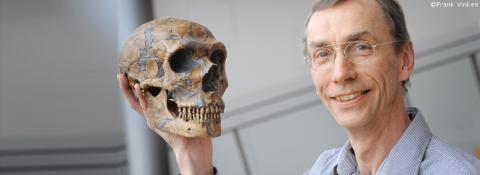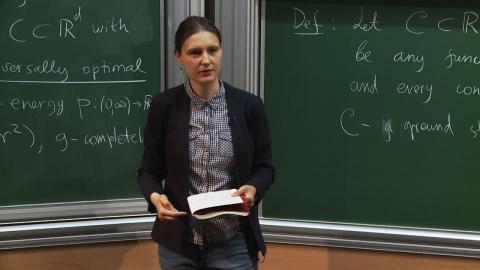Reactions to Nobel Prize in Physics for Aspect, Clauser and Zeilinger for pioneering quantum information
The Royal Swedish Academy of Sciences has awarded the Nobel Prize in Physics to Alain Aspect, John F. Clauser and Anton Zeilinger for their experiments with entangled photons, establishing the violation of Bell's inequalities and becoming pioneers in quantum information science.
Alain Aspect, John F. Clauser and Anton Zeilinger. © Nobel Prize Outreach
Alba Cervera - Nobel Física EN
Alba Cervera Lierta
Expert researcher in quantum computing at the Barcelona Supercomputing Center and coordinator of Quantum Spain
I am very excited to see that the Nobel Prize in Physics has finally been awarded to the fundamentals of quantum physics. Aspect, Clauser and Zelinger led the experiments that showed that quantum phenomena cannot be described by classical physics, and therefore go beyond it.
These findings led to quantum properties being used to develop new forms of communication and computation. In the words of the Nobel Committee for Physics: this is a Nobel that recognises the power of quantum mechanics.
Maia Vergniory - Nobel Física EN
Maia G. Vergniory
Researcher at the Max Planck for Chemical Physics of Solids in Dresden (Germany) and at the Donostia International Physics Center in Donostia-San Sebastián
The work that has been done by the scientific community over the past 50 years, moving from simply using quantum physics to understand nature to designing it, has finally been rewarded. Entangled states are the basis of the coming quantum information and technology that has already borne its first fruits.
Quantum entanglement means that multiple particles are bound together in such a way that the measurement of the quantum state of one particle determines the possible quantum states of the other particles. This connection does not depend on the location of the particles in space; it is independent of the distance between them. Even if the distance separating the entangled particles is billions of miles, a change in one particle of the particles will induce a change in the other. It's fascinating.
Enrique Solano - Nobel de Física EN
Enrique Solano
Doctor in Physics, honorary professor at the Ikerbasque Foundation and founder of the quantum technology companies Kipu Quantum and Quanvia
I am very happy to see that the 2022 Nobel Prize recognises quantum physics. The three laureate physicists, Alain Aspect, John F. Clauser and Anton Zeilinger, are brilliant and long-established candidates who have made important contributions and had a major impact.
The three laureates worked on the fundamental line of quantum information in the 1970s and 1980s using photons - not matter, but electromagnetic radiation - to verify those mysterious effects of quantum physics that occur between atomic particles at a distance.
What they verified was the principle of quantum entanglement, which says that, if you entangle or connect two atoms or two particles of light with this property, then you can put them at a distance and they still have a kind of communication that is impossible to imagine in conventional terms. There is a communication between particles due to quantum entanglement that cannot be explained in any other way than by the principles of quantum physics, which break down everyday intuition. This quantum entanglement has today been verified thousands of kilometres away.
In its beginnings, in 1900, with Max Planck, Einstein, Schrödinger and Heisenberg, quantum physics was in the framework of the theoretical; with Aspect, Clauser and Zeilinger, an era of quantum information experiments begins, the association of the principles of quantum physics with information processing arrives, and with it, quantum computation. Due to this phenomenon of quantum entanglement, it is conjectured that very soon, in five years, we will have quantum computers capable of sub-second computations that would otherwise take thousands of years with today's supercomputers. We are talking about a branch of theoretical physics that has moved into quantum technologies, a business so well established that governments in Europe, Asia and the US are investing thousands of euros in them, and there is already a global, geopolitical and technological sovereignty competition around them. I myself have created two quantum computing technology companies, one in Spain and one in Germany.
Carlos Sabín - Nobel de Física EN
Carlos Sabín
Ramón y Cajal Researcher Department of Theoretical Physics UAM Madrid
For decades, quantum entanglement was just a theoretical curiosity and quantum mechanics itself was just a good theory, which may not be a complete description of nature. The experiments led by the laureates showed, among other things, that quantum theory is the only reasonable description for results observed on the scale of a few particles, ruling out other alternatives, and that quantum entanglement is an indisputable experimental reality.
This allowed them to open the doors of experiments to the development of the field of quantum information, which has eventually given rise to modern quantum technologies, such as quantum computers, which in recent years have undergone a major development from ideas to facts.
Gloria Platero - Nobel Física 2022
Gloria Platero
Research Professor leading the research group New platforms and nanodevices for quantum simulation and computing of the Madrid Institute of Materials Science (CSIC)
The increasing development of quantum nanotechnologies and in particular quantum information has enormous implications for secure information transfer as well as quantum computing.
One of the most fascinating properties of quantum mechanics is the presence of entangled states between two particles. In such states, the particles behave as a unit, and what happens to one particle determines what happens to the other, even if the distance between them is large.
To investigate the origin of the correlation between particles, John Bell proposed a mathematical relation called "Bell inequality". The violation of this mathematical relation supported quantum mechanics as the origin of this correlation over other theories based on hidden variables.
John Clauser and Alain Aspect performed experiments based on Bell's ideas, which violated the mathematical relation proposed by Bell, thus demonstrating quantum mechanics as the basis for explaining the experimental evidence.
Anton Zeilinger also performed pioneering experiments based on entangled states and demonstrated the phenomenon known as quantum teleportation, which allows the transfer of the quantum state of a particle to a distant particle.
The contributions of Clauser, Aspect and Zeilinger have been fundamental, not only for a better understanding of the mechanoquantum properties on which information transfer is based, but also for their numerous applications in the field of new quantum technologies.
Juan José García Ripoll - Nobel Física EN
Juan José García-Ripoll
Research Scientist at the Institute of Fundamental Physics IFF-CSIC
This year's Nobel Prize in Physics is highly deserved and long anticipated. Three brilliant researchers are being honoured for experimental demonstrations that radically contributed to consolidating the foundations of quantum physics. These experiments genuinely demonstrated a property, entanglement, that cannot be explained by classical physics, using a tool, Bell's inequalities, devised by an equally brilliant scientist and also deserving of this prize. Undoubtedly, this prize is another recognition of the fundamental value of basic science, on which they are built and without which other important subsequent developments, such as quantum computing, quantum communication and quantum sensing, would be unthinkable.



